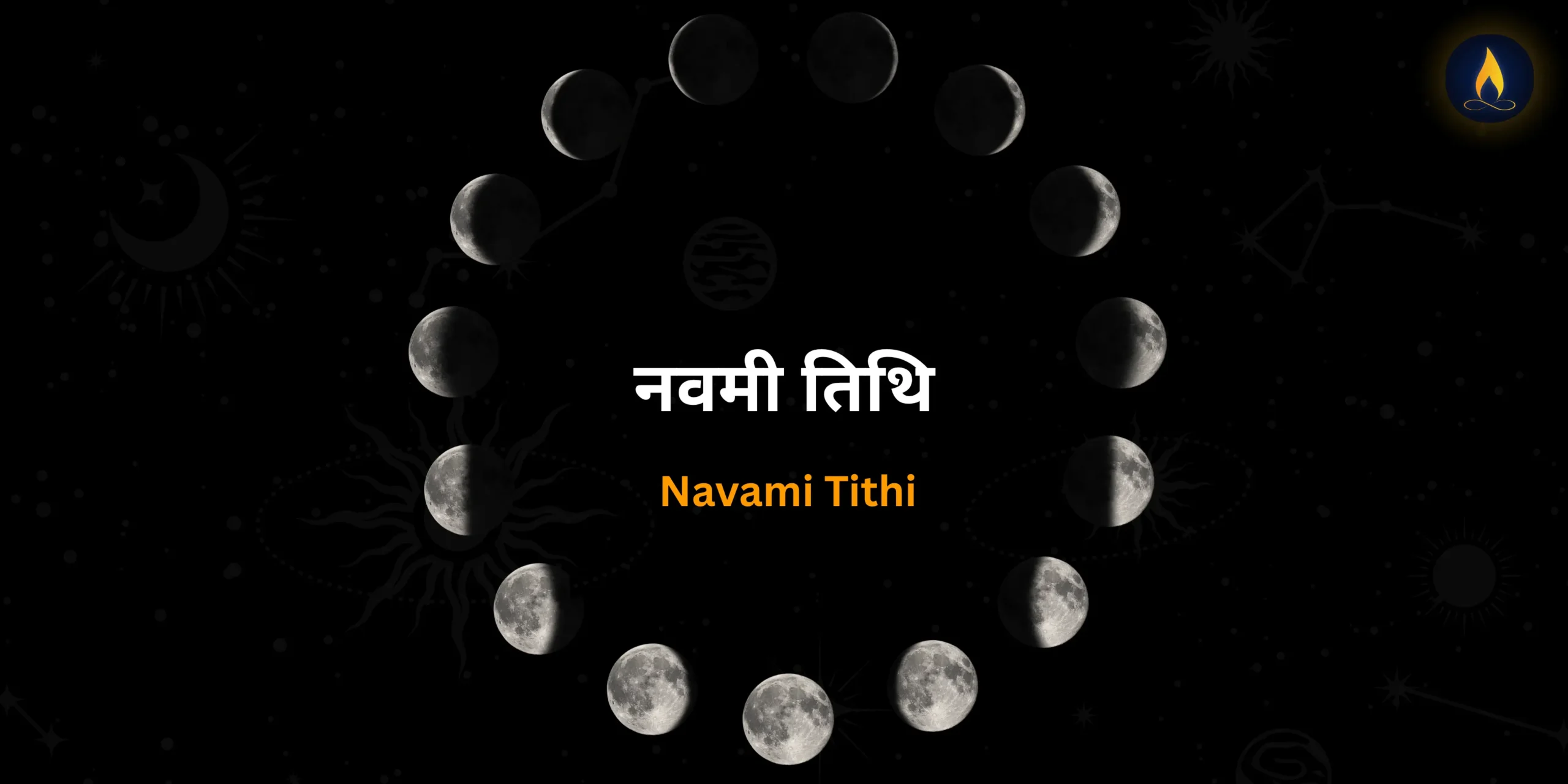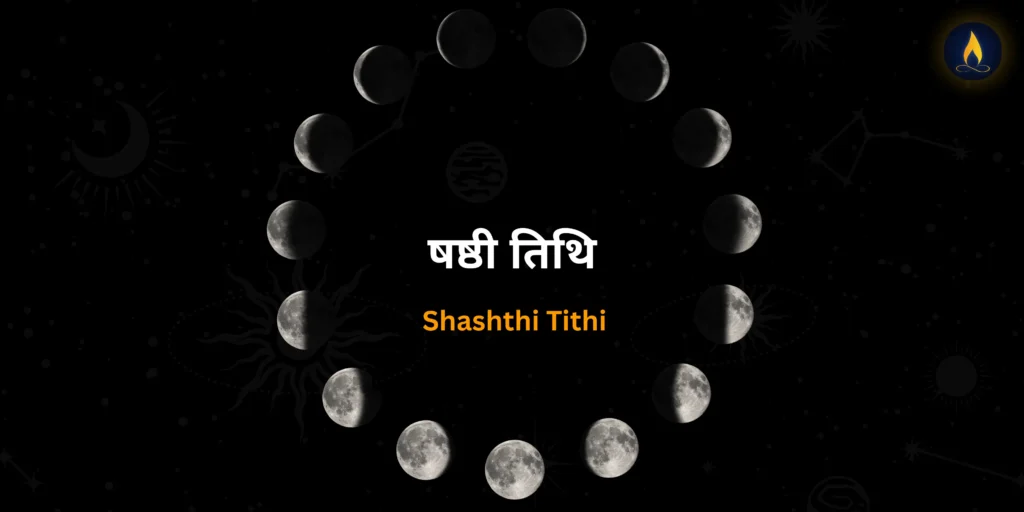Blog Contents
ToggleIn the Hindu lunar calendar (Panchang), Navami Tithi marks the ninth tithi of both Shukla Paksha (waxing moon) and Krishna Paksha (waning moon). Technically, a tithi is when the longitudinal difference between Moon and Sun increases by multiples of 12°; thus Navami spans from 96°–108°. Under that lens, Navami becomes a lunar day rich in spiritual and astrological power.
Let’s unfold what this tithi means in Vedic Astrology, Hindu tradition, and daily life 👇
🔭 What Is Navami in Vedic Astrology?
- Meaning: “Navami” derives from the Sanskrit nava meaning nine, symbolizing completeness, discipline, and divine order.
- Astronomical span: Occurs twice every lunar month; each instance varies in length (19–26 hours)
- Paksha presence: Appears in both Shukla (bright fortnight) and Krishna (dark fortnight) phases.
- Symbolic energy: Brings courage (Mars-like), ritual intensity, purification, and inner rectitude.
- Ruling deity: Shukla Navami honors Goddess Durga; Krishna Navami links to Lord Rama and ancestral rites.
- Nakshatra link: Considered a Rikta tithi—often inauspicious for ceremonies, yet ideal for competition, self-defense, and spiritual cleansing.
🌕 Shukla Paksha Navami – Fire of Victory & Dharma
Shukla Navami arrives just before Purnima, the bright culmination of the lunar month.
Energetic Qualities:
- A Jaya (victory) tithi associated with assertion, justice, and divine empowerment.
- Ideal for bold actions rooted in dharma and for cleansing through tapasya.
✅ Good Activities:
- Durga Puja/Rama Puja with red roses, ghee, and sweets
- Mantra chanting, Japa, and group sadhanas
- Sankalpa-making for personal transformation
- Fasting, charity, and kumari puja during Navratri
❌ To Avoid:
- Initiating business, marriage, housewarming, or education – it’s a Rikta tithi
- Shiva puja is inauspicious
🌟 Auspicious Timing:
- When Navami coincides with Chitra, Swati, Bharani, or Dhanishta nakshatras, the tithi’s power magnifies .
- In Ashwin Shukla Navami, it becomes Daksha Savarni Manvadi, highly fortunate for punya karma (japa, dana, homa), though still not ideal for worldly events.
🌑 Krishna Paksha Navami – Reflection & Pitru Shanti
In the waning Moon phase, Krishna Navami is introspective and calm—best suited for inner healing and ancestral work.
Energetic Qualities:
- Ugra-prada: a fierce energy good for purification, but not conflict.
- A Rikta tithi strong in ancestral connection and inner fire.
✅ Good Activities:
- Pitru Bali, offering water or food to ancestors
- Meditation, silence, and mental detox
- Rituals to cleanse the subtle mind and resolve karmic debts
❌ To Avoid:
- Commercial contracts or travel without purpose
- Loud gatherings or heavy emotional drama
- Consuming alcohol or meat
🕉️ Sanskrit Shloka & Beeja Mantra
Sacred Shloka:
“या देवी सर्वभूतेषु शक्तिरूपेण संस्थिता नमस्तस्यै नमस्तस्यै नमस्तस्यै नमो नमः।”
This timeless verse praises Durga’s omnipresence and energy, perfectly resonant on Shukla Navami.
Beeja Mantra:
ॐ दुं दुर्गायै नमः
A powerful Durga mantra—chorus it 108 times, ideally at Brahma Muhurta or evening Navami to fortify will, dispel doubts, and balance emotional energy.
Nitya Devi Mantra:
ऐं ह्रीं श्रीं ऐं क्लीं सौः कुलसुंदरी नमः।
This mantra invokes Kulasundari Devi, the Nitya Devi of Navami, and builds spiritual strength and focus.
🔮 Astrological Impacts
Strength in the Chart:
- Positive: Inspires leadership, discipline, moral courage, tapasya, diksha, ritual power – strong for warriors, activists, priests.
- Negative: If afflicted (e.g., malefic Mars, Rahu, or Saturn), may trigger anger outburst, ego, rash decisions, hostility.
Remedies:
- Fasting, Durga Kavach, Devi Mahatmyam, donation to girls, Brahmins
- Weapon worship during Navratri
- Silence, introspection to cool heated energy
🙏 Deity & Ritual Emphasis
- Shukla Navami: Worship Durga, offer ghee lamps, red flowers, sweets, kumari puja
- Krishna Navami: Honor Lord Rama (e.g., during Ram Navami in Chaitra month), and ancestral rites during Pitru Paksha
- Rituals should match Paksha context and nakshatra alignments (Chitra, Swati, Bharani are favorable)
🧘♀️ Spiritual Significance
Navami is a day to channel energy inward and align with higher purpose:
- For tantra and mantra, it deepens personal resolve
- For bhakti, it clarifies intentions and stokes inner devotion
- For yoga, improves concentration and internal transformation
- Recommend red, white, copper donations, mantra japa, fasting, study or silence
Festivals & Observances
Shukla Navami Celebrations:
- Maha Navami (Ashwin): climax of Navratri; weapon worship, kumari puja, fasting
- Ram Navami (Chaitra): marking Lord Rama’s birth; bhajan, Ramayana recitations, charity.
Krishna Navami Observances:
- Avidhava Navami during Bhadrapada: widow rituals for pitru shanti
- Sacrifices or rites for forefathers
Regional Traditions:
- In Nepal and Mithila: Sita Navami (Vaishakha Shukla): celebration of Sita’s birth – involves planting Parijat trees, reciting epics.
📋 Activities – Auspicious & Inauspicious
✅ Ideal Uses:
- Combat inner weakness; start fasts, kriya-sadhana
- Charitable deeds, women’s empowerment gestures
- Weapon consecration, energetic rituals with clear intent
- Spiritual study, journaling, mantra japa
❌ To Avoid:
- Weddings, buying property, contracts, travel for fun
- Heavy celebration, partying, meat, alcohol, ego-fighting
- Meditation or pacific rituals during aggressive nakshatra alignments
🕰️ Muhurta & Panchang Tips
- Match Navami with Swati, Chitra, Bharani, or Dhanishta nakshatras for auspicious results
- Avoid pairing with Krittika, Ardra, or moon signs Cancer/Leo on this tithi – it’s then called Tithi Shoonya and often discouraged.
- Use trusted Panchang or Astro Apps for live muhurta guidance and Nakshatra details
🧠 Psychological & Character Notes
- People born on Navami Tithi often embody courage, discipline, leadership; they’re industrious, principled, and spiritually oriented.
- While endowed with resilience, they may need to balance fierce energy with compassion and diplomacy.
Since Tithis are directly influenced by the Moon’s position, explore this article to learn more about the Moon in astrology.
🧾 Key Takeaways
- Navami Tithi = 9th lunar day (96°–108° Sun‑Moon lag), potent for energy work.
- Shukla Navami = power, protection; best for Devi worship & spiritual study.
- Krishna Navami = reflection, inner cleansing, ancestral rites.
- Ideal aligned with Durga, Rama, ancestors; unfavorable for mundane tasks.
- Avoid weddings, travel, business starts, heavy foods, emotional drama.
- Use Navami to strengthen will, conquer inner foes, deepen devotion.
FAQs
Is Navami Tithi good for travelling?
Navami Tithi is generally not suitable for regular travel. But if the journey is spiritual—like a pilgrimage or temple visit—it becomes acceptable, especially with favorable nakshatras like Swati or Chitra. Always check your Panchangam for muhurta and planetary support.
What is Krishna Navami Tithi?
Krishna Navami is the ninth day of the waning Moon, linked with ancestor worship, silence, and spiritual rest. It is best for Pitru Tarpan, lighting a diya, and disconnecting from external noise for mental peace and karmic release.
Which God is Navami Tithi for?
In Shukla Paksha, Navami is ruled by Durga Mata, while in Krishna Paksha, it connects with Lord Rama and forefathers. Both energies promote strength, dharma, and emotional healing through prayer or rituals.
Is Navami a good Tithi?
Yes, Navami is ideal for spiritual and inner work like fasting, puja, or self-discipline. It’s not the best time for starting worldly tasks such as weddings or financial ventures, but it builds mental and spiritual power.
What is special about Navami?
Navami represents victory over darkness, seen in stories of Durga and Rama. It encourages you to overcome fear, reconnect with your purpose, and take action with spiritual awareness and inner strength.









